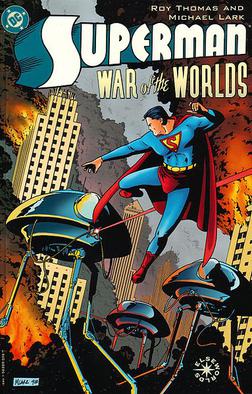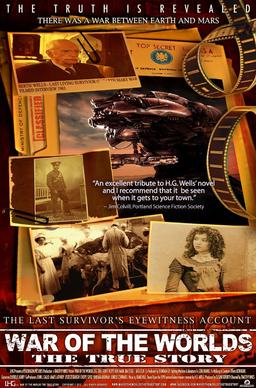Related Research Articles

Mars, the fourth planet from the Sun, has appeared as a setting in works of fiction since at least the mid-1600s. Trends in the planet's portrayal have largely been influenced by advances in planetary science. It became the most popular celestial object in fiction in the late 1800s, when it became clear that there was no life on the Moon. The predominant genre depicting Mars at the time was utopian fiction. Around the same time, the mistaken belief that there are canals on Mars emerged and made its way into fiction, popularized by Percival Lowell's speculations of an ancient civilization having constructed them. The War of the Worlds, H. G. Wells's novel about an alien invasion of Earth by sinister Martians, was published in 1897 and went on to have a major influence on the science fiction genre.
The War of the Worlds is an 1898 science fiction novel by H. G. Wells.

Alien invasion or space invasion is a common feature in science fiction stories and films, in which extraterrestrial lifeforms invade Earth to exterminate and supplant human life, enslave it, harvest people for food, steal the planet's resources, or destroy the planet altogether. It can be considered as a science-fiction subgenre of the invasion literature, expanded by H. G. Wells's seminal alien invasion novel The War of the Worlds, and is a type of 'first contact' science fiction.

"The War of the Worlds" was a Halloween episode of the radio series The Mercury Theatre on the Air directed and narrated by Orson Welles as an adaptation of H. G. Wells's novel The War of the Worlds (1898) that was performed and broadcast live at 8 pm ET on October 30, 1938, over the CBS Radio Network. The episode is famous for inciting a panic by convincing some members of the listening audience that a Martian invasion was taking place, though the scale of panic is disputed, as the program had relatively few listeners.

H. G. Wells' War of the Worlds, also known as Invasion and H. G. Wells' The Worlds in War internationally, or simply as War of the Worlds, is a 2005 Japanese-American direct-to-DVD independent fantasy horror film produced by The Asylum, which premiered on Sci Fi Channel on Tuesday June 28, 2005, and directed by David Michael Latt. It is a loose adaptation of the H. G. Wells novel, and a mockbuster of the DreamWorks/Paramount film based on the same source, in addition to the third film adaptation overall.

First contact is a common theme in science fiction about the first meeting between humans and extraterrestrial life, or of any sentient species' first encounter with another one, given they are from different planets or natural satellites. It is closely related to the anthropological idea of first contact.

HMS Thunder Child is a fictional ironclad torpedo ram of the Royal Navy, destroyed by Martian fighting-machines in H. G. Wells' 1898 novel The War of the Worlds whilst protecting a refugee rescue fleet of civilian vessels. It has been suggested that Thunder Child was based on HMS Polyphemus, which was the sole torpedo ram to see service with the Royal Navy from 1881 to 1903.

The fighting machine is one of the fictional machines used by the Martians in H. G. Wells' 1898 classic science fiction novel The War of the Worlds. In the novel, it is a fast-moving three-legged walker reported to be 100 feet tall with multiple, whip-like tentacles used for grasping, and two lethal weapons: the Heat-Ray and a gun-like tube used for discharging canisters of a poisonous chemical black smoke that kills everything. It is the primary machine the Martians use when they invade Earth, along with the handling machine, the flying machine, and the embankment machine.

Many works of fiction have featured UFOs. In most cases, as the fictional story progresses, the Earth is being invaded by hostile alien forces from outer space, usually from Mars, as depicted in early science fiction, or the people are being destroyed by alien forces, as depicted in the film Independence Day. Some fictional UFO encounters may be based on real UFO reports, such as Night Skies. Night Skies is based on the 1997 Phoenix UFO Incident.

The Martians, also known as the Invaders, are the main antagonists from the H.G. Wells 1898 novel The War of the Worlds. Their efforts to exterminate the populace of the Earth and claim the planet for themselves drive the plot and present challenges for the novel's human characters. They are notable for their use of extraterrestrial weaponry far in advance of that of mankind at the time of the invasion.

Scarlet Traces is a Steampunk comic series written by Ian Edginton and illustrated by D'Israeli. It was originally published online before being serialised in 2002, in the British anthology Judge Dredd Megazine. A sequel, Scarlet Traces: The Great Game, followed in 2006.

Superman: War of the Worlds is a DC Comics Elseworlds graphic novel, published in 1998, written by Roy Thomas with Michael Lark as the artist. The story is a rough adaptation of the H. G. Wells 1898 novel The War of the Worlds, but is primarily based on the Superman mythology. Wells' story is transported from early 20th century Britain to Metropolis in 1938, where the Martian invasion is met with a Golden Age-style Superman who is not blessed with the full range of powers that he typically has in modern comics.

H. G. Wells' The War of the Worlds is a 2005 direct-to-video independent science fiction action horror-thriller film version adaptation of H. G. Wells's 1898 novel of the same name about a Martian invasion of southern England. This version was produced by the independent film company Pendragon Pictures. Unlike the adaptations set in the current day United States, this was the first film set in the novel's original 1898 Victorian England. In 2012, a re-formatted, re-worked version of the film was released as War of the Worlds – The True Story.

War of the Worlds 2: The Next Wave is a 2008 direct-to-DVD science fiction-thriller film by The Asylum, which premiered on Syfy on Tuesday March 18, 2008, directed by and starring C. Thomas Howell. The film was produced and distributed independently by The Asylum.
"A Day in Beaumont" is the first segment of the twenty-fourth episode of the first season of the television series The Twilight Zone. In this segment, a couple spends an entire day trying to convince the people of a small town that aliens have landed nearby.

The War of the Worlds is a 1953 American science fiction thriller film directed by Byron Haskin, produced by George Pal, and starring Gene Barry and Ann Robinson. It is the first of several feature film adaptations of H. G. Wells' 1898 novel of the same name. The setting is changed from Victorian era England to 1953 Southern California. Earth is suddenly invaded by Martians, and American scientist Doctor Clayton Forrester searches for any weakness to stop them.

War of the Worlds: The True Story is a 2012 American made-for-television science fiction-action film remake of H. G. Wells' The War of the Worlds based on English writer H. G. Wells's epic 1898 science fiction novel The War of the Worlds. A documentary-style drama directed by Timothy Hines, it revisits Wells' novel, portraying the events of the book as historical, through the documented recollections of a survivor of the Martian war.

The War of the Worlds is a science fiction novel by English author H. G. Wells. It was written between 1895 and 1897, and serialised in Pearson's Magazine in the UK and Cosmopolitan magazine in the US in 1897. The full novel was first published in hardcover in 1898 by William Heinemann. The War of the Worlds is one of the earliest stories to detail a conflict between humankind and an extraterrestrial race. The novel is the first-person narrative of an unnamed protagonist in Surrey and his younger brother who escapes to Tillingham in Essex as London and southern England is invaded by Martians. It is one of the most commented-on works in the science fiction canon.

"The Night America Trembled" is a television dramatization of the public reaction to the 1938 radio broadcast of "The War of the Worlds" that aired September 9, 1957, as an episode of the CBS series Westinghouse Studio One. Hosted by Edward R. Murrow, the live documentary play was written by Nelson S. Bond, and uses excerpts of the radio script by Howard E. Koch.

The Massacre of Mankind (2017) is a science fiction novel by the British writer Stephen Baxter, a sequel to H. G. Wells' 1898 classic The War of the Worlds, authorised by the Wells estate. It is set in 1920, 13 years after the events of the original novel, as a second Martian invasion is chronicled by Miss Elphinstone, the ex-sister-in-law of the narrator of War of the Worlds. Baxter also wrote an authorised sequel to Wells' novel The Time Machine, called The Time Ships.
References
- ↑ Miller, Thomas Kent. Mars in the Movies: A History. Jefferson, North Carolina: McFarland & Company, 2016. ISBN 978-0-7864-9914-4
- ↑ "New World forms two new kidvid banners". Variety. 8 December 1992. Retrieved 27 May 2014.
- ↑ "New World Expands TV Program Activities". Los Angeles Times . 9 December 1992. Retrieved 27 May 2014.
- ↑ "When Star Trek voices restaged the 1938 Martian invasion". 24 October 2021.
- ↑ "Dumb.com Old Time Radio Show Episode - XXXXXX - [56] Orson the Alien MP3". Archived from the original on 12 January 2020. Retrieved 12 January 2020.
- ↑ "R&P Alerta, Capitulo 1". Archived from the original on 15 December 2021. Retrieved 8 December 2017– via YouTube.
- ↑ "14. The Martian Invasion of Earth - Big Finish Classics". Bigfinish.com.
- 1 2 3 4 "The Martian Diaries - The War Of The Worlds Sequel". Martiandiaries.com. Retrieved 24 June 2022.
- ↑ "The War of The Worlds". The War of The Worlds. Retrieved 24 June 2022.
- ↑ Walls, Seth Colter (13 November 2017). "Review: A 'Fake News' Opera on the Streets of Los Angeles". The New York Times . Retrieved 1 November 2018.
- ↑ Kiphshidze, N; Zubiashvili, T; Chagunava, K (October 2005). "The Creation of Space Invaders". Edge . No. 154. Future plc. pp. 7–13.
- ↑ War of the Worlds - New Survival Gameplay Highlights, 12 November 2022, retrieved 16 November 2022
- ↑ "SonicWALL - Blocked by Application Firewall". Archived from the original on 27 July 2011. Retrieved 23 January 2010.
- ↑ "War of the Worlds trading cards from Monsterwax". Monsterwax.com. Retrieved 24 June 2022.
- ↑ "The Solar Pons Gazette" (PDF). Solarpons.com. December 2008. Retrieved 24 June 2022.
- ↑ "War of the Worlds 2017". War of the Worlds 2017. Retrieved 24 June 2022.
- ↑ "S5E5: Outreach". Unwell Podcast. Retrieved 7 June 2023.
- ↑ {{Cite web https://www.amazon.co.uk/War-Worlds-Stageplay-brand-adaptation-ebook/dp/B0CBSTVS7N/?_encoding=UTF8&pd_rd_w=aYrkK&content-id=amzn1.sym.72fa84e5-4730-4039-9e38-3a9afc8c18e9%3Aamzn1.symc.adba8a53-36db-43df-a081-77d28e1b71e6&pf_rd_p=72fa84e5-4730-4039-9e38-3a9afc8c18e9&pf_rd_r=2BJ57S3CJ96CMV9ATP0P&pd_rd_wg=Kzvlw&pd_rd_r=69e188b0-fa89-4710-ae30-d064b32807f9&ref_=pd_gw_ci_mcx_mr_hp_atf_m}}
- ↑ Lovgren, Stefan (17 June 2005). "'War of the Worlds': Behind the 1938 Radio Show Panic". National Geographic. Archived from the original on 7 October 2018. Retrieved 7 October 2018.
- ↑ Pooley, Jefferson; Socolow, Michael (28 October 2013). "The Myth of the War of the Worlds Panic". Slate . Retrieved 29 September 2016.
- ↑ "Errors - Big Finish". Archived from the original on 20 April 2021. Retrieved 24 June 2022.
- ↑ "Ray Harryhausen War of the Worlds Martian..." 13 August 2009. Retrieved 24 June 2022– via YouTube.
- ↑ "Ray Harryhausen and Nick Park". Archived from the original on 21 November 2008. Retrieved 24 June 2022.
- ↑ Edison's Conquest of Mars, "Foreword" by Robert Godwin, Apogee Books 2005
- ↑ "La Cage de Londres". Alire.com. Retrieved 31 May 2017.
- ↑ Norris, Andrew (December 2008). "Solar Pons' War of the Worlds" (PDF). The Solar Pons Gazette. 3 (1): 19–33.
- ↑ Baxter, Stephen (19 January 2017). The Massacre of Mankind. Gollancz.